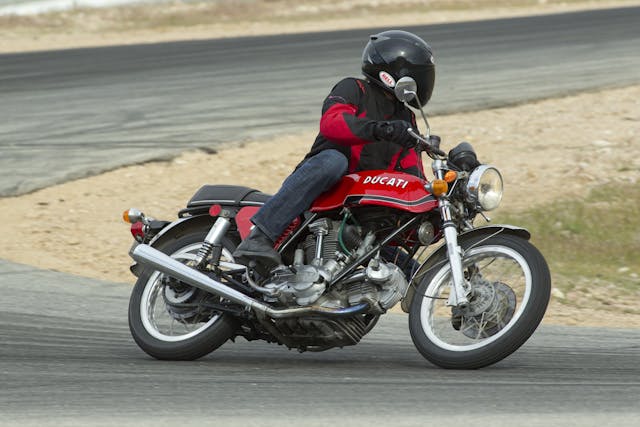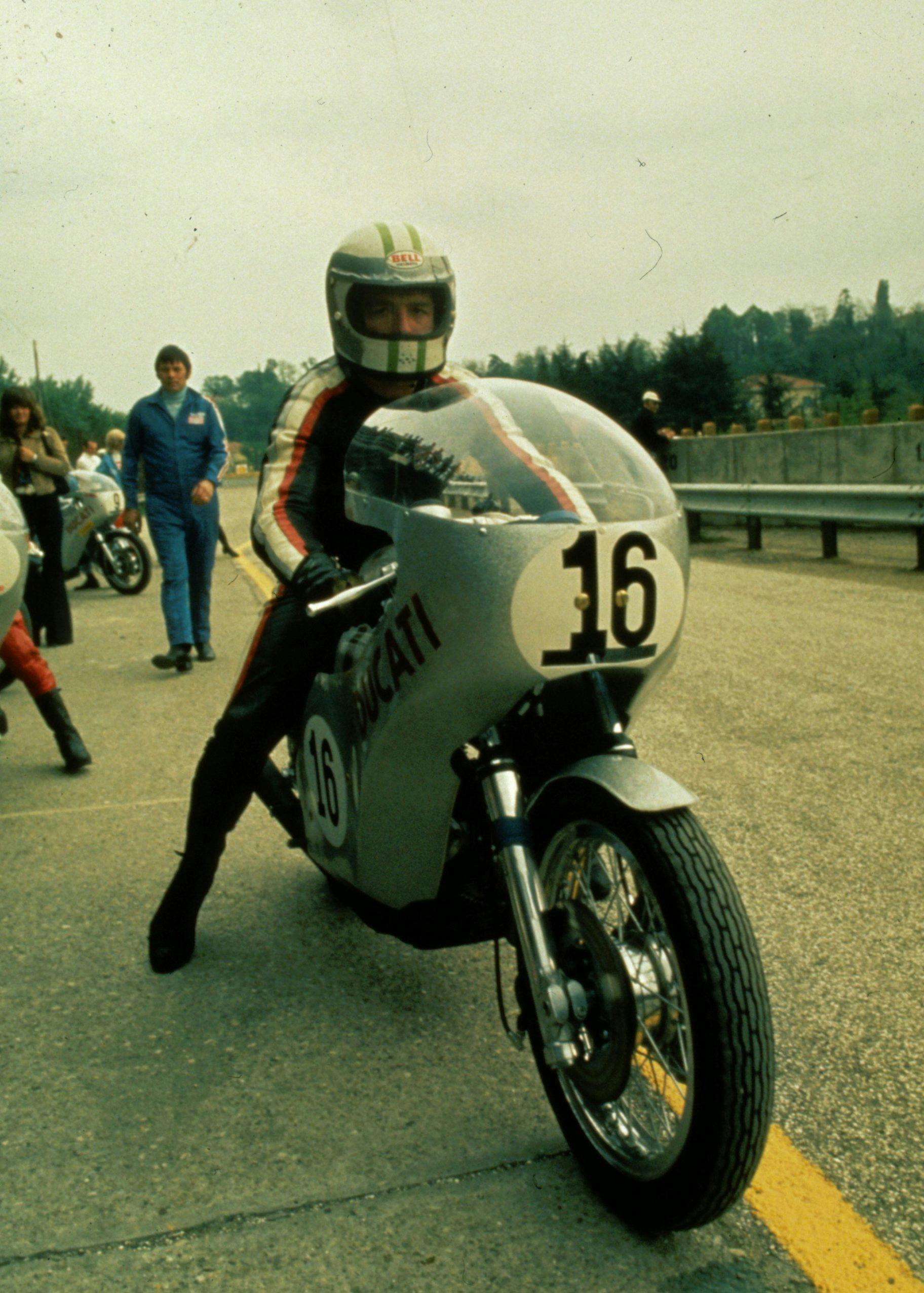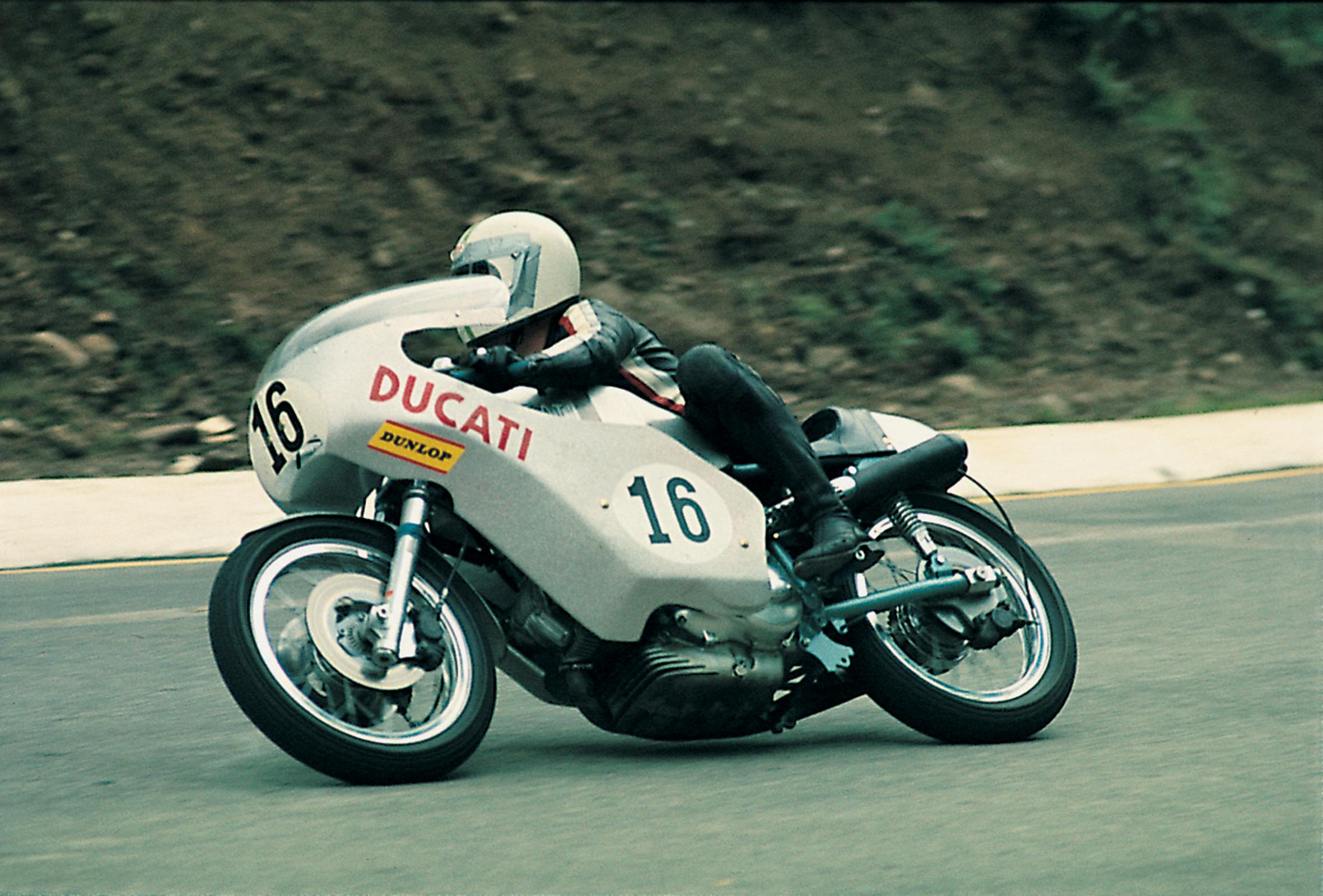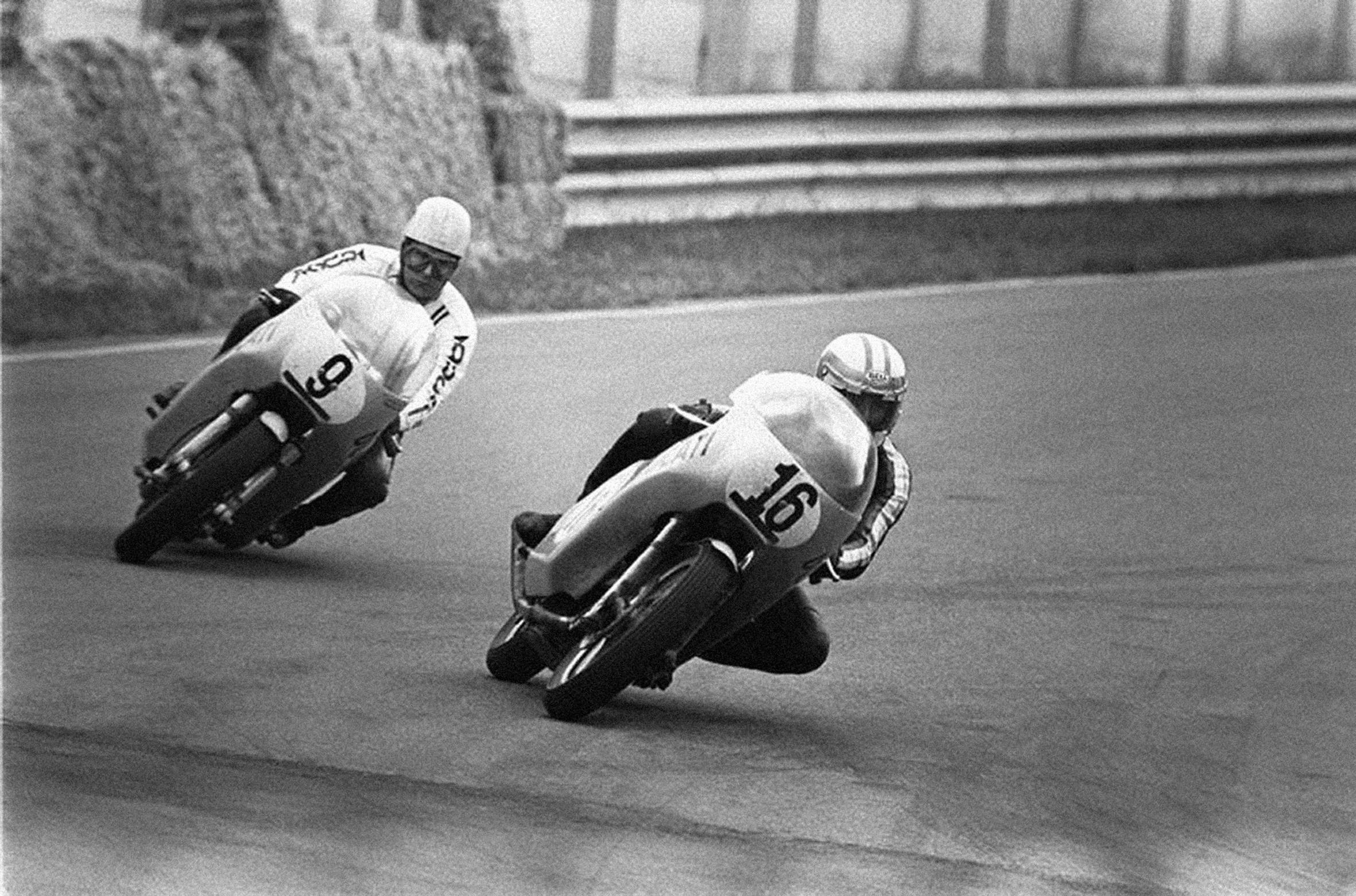Media | Articles
50 years ago, Ducati’s distinctive V-twin birthed a dynasty
The Age of Aquarius brought more than long hair, bell-bottoms, and rebellion. It also launched the age of superbikes, which drastically redefined motorcycle engineering, performance, and design. From 1969 forward, it was game on as manufacturers brought forth new, high-revving, multicylinder street bikes bristling with racing technology. Two-stroke and four-stroke engines in two-, three-, four- and six-cylinder configurations—take your pick. Exciting as hell, these hypermachines overwhelmed traditional street bikes like so many peregrine falcons hunting pigeons in steep, fast dives. Quite simply, superbikes were the most exciting thing on wheels.
For these newcomers, certain targets were easy. Harley-Davidson’s Sportster was a mess—torquey but jackhammer-buzzy and ungainly. England’s hot-rod Norton Commando and Triumph Trident were both based on ages-old pushrod designs. The real action was from Japan, notably Kawasaki’s blistering Mach III two-stroke triple and Honda’s stupefying CB750 Four. BMW wasn’t even a player, and Italy’s Laverda and MV Agusta were few and far between.
And then, there was Bologna-based Ducati, founded in 1926 by brothers Adriano, Bruno, and Marcello Ducati as an electronics firm. In the 1940s, the company began producing little clip-on engines for bicycles, followed by simple, lightweight motorcycles. This changed with the arrival in 1954 of Fabio Taglioni, a former Mondial racing engineer with a passion for bevel-gear-driven overhead-camshaft motors. From 1957 on, the company offered a growing fleet of these exotic small-displacement street bikes, eventually up to 450cc. However, Ducati’s inability or disinterest in evolving beyond singles became a liability as the Japanese multis advanced at a rapid pace. Thus, building a big bike wasn’t a luxury so much as essential for Ducati to enter the emerging superbike segment and survive.

The task of getting Ducati into the superbike game fell on Taglioni. His formula was an air-cooled 748cc 90-degree V-twin that measured barely 15 inches wide, a crucial half-foot narrower than a Honda CB750 mill. The engine was thus carried deep in the GT’s tubular-steel spaceframe, lowering the center of mass while preserving ground clearance when the machine was banked over. Inventively, the alloy engine cases, which held an outrageous 5 quarts of oil, were stressed members of the frame, Formula 1-style. This structure allowed the use of nearly straight frame tubes, and with a low curb weight of 438 pounds, the new 750 GT instantly became the best handling big bike of them all—especially compared with Japanese multis that offered more power than handling. The 750 GT felt like it cornered on rails, its stability never deviating, with feedback precise and reassuring.
Debuting in America as the 1972 750 GT, this lithe roadster earned acclaim for the nearly vibration-free performance of its bellowing, torquey engine. Soon after the bike debuted, reports emerged that with a nickel balancing on its edge on the crankcases, the V-twin could rev close to redline without the coin falling. It was true.
Marketplace
Buy and sell classics with confidence

The inner beauty of the new engine was its exotic bevel-drive arrangement for the overhead camshafts, derived from Ducati’s singles. Located on the right side of the engine, the system used no chains, pushrods or belts; instead, nine helical gears moved crankshaft motion to twin tower shafts, which turned a camshaft in each head. The advantages were precise cam timing, minimal reciprocating mass, and high-speed reliability. More gears drove the distributor and oil pump, and deeper inside the engine, both connecting rods rode on a single crankpin, using roller-bearing big ends on the assembled crankshaft—which was so robust that it required 20 tons of tool pressure to build it.
On the left side, more helical gears transferred power rearward through a multiplate wet clutch to the five-speed dog-box transmission. And the kick-start mechanism required yet another gear set. This raised the total gear count in a Ducati 750 powertrain above two dozen. Thanks to Taglioni’s resourcefulness, engineer-ing acumen, and artistry, trusted decades-old solutions formed an exciting new product in a fashion that only Italy could (and would) produce.
Although the Japanese blended manufacturing efficiencies with performance, Ducati’s masterpiece proved complex, expensive, and time-consuming to assemble. The crankshaft and most gears in the valve-train and gearbox were hand-shimmed. But never mind, because Taglioni had even loftier goals: In a stroke of mad genius, to create seven factory race bikes for the 1972 Imola 200 race, he adopted a sublimely exotic desmodromic valvetrain, or one that both opens and closes the valves.
Following Mercedes-Benz’s use of desmodromics on the 1954 W196 “Silver Arrow” F1 cars, Ducati had built racing desmo singles beginning in the mid-1950s, along with a desmodromic street bike, the 350cc Mark 3D, in 1968. But the Imola 750s were the world’s first desmodromic V-twins. Instantly, the technology, intended to eliminate the rev limitations inherent in common valve springs, became a cornerstone of Ducati motorcycle manufacturing that continues today.
Using four cam lobes and two pairs of rocker arms for each cylinder, the Imola bikes’ desmodromic systems mechanically opened and closed the valves, eliminating springs, high-speed valve float, and, of course, any potential of spring breakage. Additionally, since the valves were closed mechanically, the cams could feature steeper closing ramps to optimize valve timing. Translation: A redline approaching 10,000 rpm and a higher specific output without hurting drivability.

The Imola 750s were credited with making 84 horsepower, or 112 horsepower per liter—23 percent above the specific output of a Porsche 904’s flat-six, which had gear-driven overhead cams but no desmodromics. Capable of 150 mph, the Ducati sported a specially narrowed frame, aerodynamic bodywork, straight-cut primary gears, works twin-plug heads, and triple disc brakes. Compared with the standard 750 GT, the Imola racers were like a Ferrari 250 GTO next to a 250 GT 2+2.
The story has been retold ad infinitum, but on April 23, 1972, team-mates Paul Smart and Bruno Spaggiari finished 1-2 at Imola on the factory racers, vaulting Ducati and its new 750 V-twin onto the world stage.
Euphoric after the win, management promised a street replica of the desmo race bikes. Faithfully, two years later, the company produced the hallowed 750 Super Sport, a limited-production sportbike featuring a desmo valvetrain, giant 40-millimeter Dell’Orto pumper carburetors, and abbreviated bodywork derived from the Imola racer forms. The 750 SS—lacking airboxes and effective mufflers, producing as much noise from its gears as a machine-gun nest, and shifting on the right side in a reverse pattern—somehow ended up street-legal in the U.S. Setting the valves ideally required dropping the engine from the frame and removing the cylinder heads, rocker pins, and rocker arms to replace up to 32 individual valve and rocker-pin shims as needed. This two-day job was required every few thousand miles.

The 1974 750 Super Sport, nicknamed “Greenframe” for its duck-egg-turquoise frame paint, was unquestionably the pinnacle of street bikes. With race-spec tires and high exhausts installed, it made a terrific production racer right out of the crate. It was such a good platform that a fully developed 750 SS created by privateers Phil Schilling and Cook Neilson won the 1977 Daytona Superbike race outright, Ducati’s highest honor on American soil.
In between the 750 GT and 750 Super Sport came the 750 Sport, a solar-yellow devil with racy clip-on handlebars, rear-mounted footrests and controls, a high-compression engine, and a solo seat. And thus, by 1974, there were three spectacular bevel-drive 750s in the lineup. Factoring in the Imola win and favorable magazine tests (the 750 GT was “the bike that everyone wanted to ride home,” wrote Cycle magazine in its “Superbikes 1973” comparison), Ducati was indeed flying high. And it charged accordingly. The new GT cost $1995, double the $999 cost of the first Mach III and a third more than the original CB750 at $1495. For the customer who want-ed rarefied engineering, elegant Italian design, good performance, and unmatched handling, price was no deterrent. But for mainstream buyers, it was too much.
Soon enough, cost-cutting began to dilute the purity of the original 750 GT. The lovely Borrani aluminum rims gave way to chromed steel. The superb Lockheed front brake caliper was replaced by uninspired Italian knock-offs. Federal regulations banished the delicate fiberglass gas tank in lieu of stamped steel, and the original jewel- like stainless fenders ceded to painted pieces. As well, Smiths gauges morphed into Veglia units, and the early dashboard annunciators charmingly labeled GEN, ABB, and LUCI in Italian received—Mio Dio!—a redesigned cluster with English labels for the ignition, lights, and high beam. Worst of all, the infamous Conti mufflers, which embellished the V-twin’s dragster-like loping idle and high-rpm shout, were expunged for unwieldy Lafranconi mufflers. The list went on.
When the 750 GT sunsetted in 1975, it was replaced by the 860 GT, an enlarged bevel-drive V-twin featuring divisive Giugiaro styling. This led to thankfully more enchanting models such as the rakish 900 Darmah—the first “mainstream” Ducati with desmo valve gear—the 900 Super Sport, and the beloved 900 Mike Hail-wood Replica (MHR). Thousands of MHR road bikes were produced through 1985, the last of which, known as the Mille, displaced nearly a full liter. Throughout this journey, the build and maintenance costs of the bevel-drive engines remained high, hampering Ducati in the marketplace. Finally, almost 30 years after Ducati’s first overhead-camshaft singles, the bevel-drive era was done.
But Ducati certainly wasn’t. Once more under Taglioni’s direction, necessity took the form in 1980 of a new range of 500cc-and-larger Pantah V-twins, whose origins lay in an experimental 500 GP bike from 1971. Overlapping with the final MHR Mille model in 1985, the little Pantah used a toothed-belt camshaft drive and contemporary manufacturing techniques. Ducati V-twins have built on this ever since, resulting in today’s audacious Panigale V2, a $17,000 desmo V-twin street bike with a power-to-weight ratio well over double that of a $200,000 Porsche 911 Turbo S.
That is some kind of spectacular. And so, if you like Ducati today, you can thank Dr. T and his ingenious, irreplaceable 750 GT.













If the 750 GT had a sales price of $1995 in 1972, It was less than 20% more than the 1972 CB750K2, which retailed for $1702. Inflation between 1969 and 1972 was about 14% (total). For perspective on the specific output of the 750 GT, the Cosworth DFV, 3 liter V8 formula one engine produced 150hp/liter by 1972.